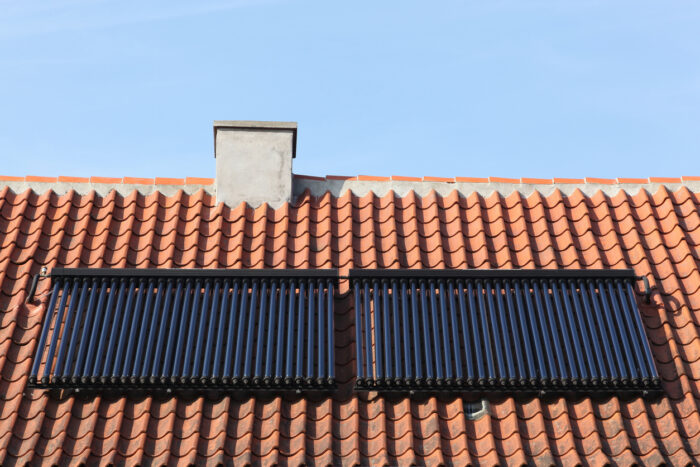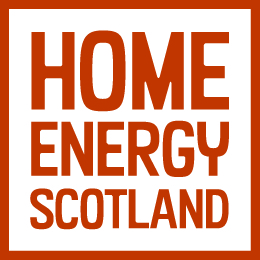Solar thermal
A solar thermal system uses the sun’s energy to provide hot water for your home. It can cover about half the hot water needs of a typical household.

Solar thermal systems use free, renewable sunlight to supply your home with hot water.
This means the hot water you get from solar thermal is also free and environmentally friendly.
What is a solar thermal system?
Like solar PV panels, solar thermal systems use energy from the sun. Rather than generating electricity, they provide hot water for your property. For this reason, they’re also known as solar hot water systems.
Solar thermal collector panels are installed on the roof of your home. They collect heat from the sun and use this to heat up water, which is stored in a hot water cylinder or thermal store.
How does solar thermal work?
Solar thermal panels – also called solar thermal collectors – are installed on your roof. The collectors receive a mix of water and antifreeze. The solar thermal panels use the sun’s heat to warm this liquid as it passes through them.
Once the liquid is heated, it’s sent to your hot water cylinder. The liquid moves through the cylinder’s coil, heating the water around it. Your taps or shower then draw from this store of hot water.
The solar thermal collectors are either:
Evacuated tubes
These are a row of glass tubes attached to the roof. Inside each tube is another tube. Between the outer and inner tube is a vacuum. This keeps the heat from escaping, making the solar thermal system more efficient.
Flat plates
These look like window frames fitted with tinted glass. They’re made up of several layers. Each layer has a different role in heating up the fluid to send to your hot water cylinder.
Solar thermal pros and cons
- Can cover around 50% of your hot water needs
- Low carbon option for hot water
- Incompatible with most combi boilers
- Requires a hot water cylinder or thermal store
Will a solar thermal system save me money?
The hot water from your solar panels is free because it’s heated by the sun. Throughout the year, around half of your hot water will come from your panels. The other half will come from your existing system. This means you should save around 50% on your hot water bills.
How much you save will depend on what system you’re currently using. The Energy Saving Trust have worked out you’ll save the most – around £275 – if you’re currently using electricity to heat your water. If you have a gas boiler, you’ll save around £160.
Solar thermal: what to consider
If you’re looking to lower your energy bills and reduce your carbon footprint, a solar hot water system certainly ticks both boxes. We’ll go through some of the practical considerations below.
If you have a boiler which uses a hot water tank, then it’s very likely that your current set up will work with a solar thermal system.
If you have a combi (combination) boiler, you’ll first need to check that it can work with pre-heated water. The manufacturer or the manual should give you this information.
If your combi boiler can only accept cold water, you’ll need to replace it. This might be something to consider if your current boiler is old or faulty.
Ideally, solar thermal collectors should be placed on a south-facing roof. If your property is east or west-facing, it’s sometimes possible to put solar thermal panels on either side of your roof. Unfortunately, north-facing roofs don’t get enough sunlight to make a solar thermal system worthwhile. If you have a north-facing roof, you could install the panels on the ground or a wall.
As well as facing the right way, your roof also needs to get direct sunlight. This means it can’t be shaded by buildings or trees.
In terms of roof space, you’ll need about five square meters for a typical solar thermal system.
A solar thermal system needs its own coil inside the hot water cylinder. Your boiler is already using the coil in your current hot water cylinder. This means you’ll either need to:
Replace your hot water cylinder
The new hot water cylinder would have two coils inside it. One coil would be at the top, the other would be at the bottom. The solar hot water panels heat the bottom coil. The boiler heats the top coil. This means most of the hot water comes from the panels instead of the boiler.
Add a second hot water cylinder
Like the old cylinder, the new cylinder would have a single coil inside it. The old cylinder stays connected to your boiler. The new cylinder connects to your solar thermal system. The panels heat the water in the new cylinder, then send this water to the old cylinder. Since the water going into the new cylinder is already warm, the boiler doesn’t need to use as much energy to get it to the right temperature.
Solar thermal costs and funding
Installation costs
Installing a solar thermal system will usually cost between £3,000 and £5,000.
A system that uses flat plate solar thermal collectors will usually be less expensive than one which uses evacuated tubes.
See our funding section below to see what help is available for covering installation costs.
Maintenance costs
A solar hot water system doesn’t need much maintenance. If well looked after, it can last for 25 years.
The system should be checked over by an installer every five years. They’ll need to replace the antifreeze in the system, as this breaks down over time. They’ll also need to check, and possibly replace, the pump. The pump should last around ten years if it’s well maintained.
Funding for solar thermal systems
Home Energy Scotland offer a £5,000 interest-free loan to help cover the costs of a solar thermal system. For the most up-to-date information about solar thermal funding, visit the Home Energy Scotland grant and loan page. Alternatively, you can call Home Energy Scotland free on 0808 808 2282.
Register your interest in EcoCosi from Changeworks
Find out more about how our home retrofit service can help make your home warmer and more comfortable, as well as lower your energy bills.

Changeworks delivers Home Energy Scotland in the south east and Highlands and Islands on behalf of the Scottish Government and Energy Saving Trust.
As well as providing free, impartial expert advice to thousands of people every month to help them to keep warm in their homes for less, they identify funding opportunities for households seeking to install energy efficiency measures.
For more information, give Home Energy Scotland a call on 0808 808 2282 or email and the team will be happy to help you.
Useful pages
Is this page useful?